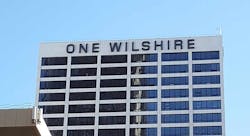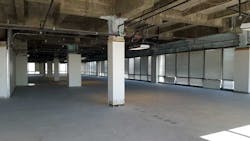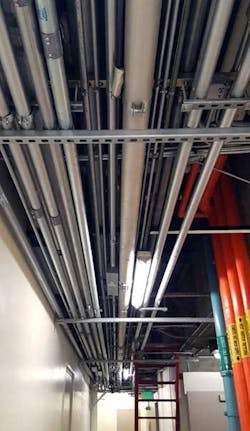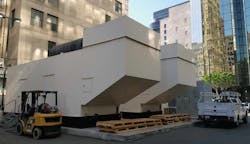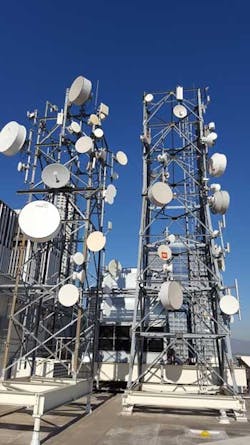LOS ANGELES – One of the world’s most connected buildings is getting a power boost. The owners of One Wilshire, the iconic carrier hotel in downtown Los Angeles, have begun a series of infrastructure upgrades that will provide the building with up to 28 megawatts of additional data center capacity.
One Wilshire is owned by GI Partners, which is investing in projects to make room for more riser space and electrical infrastructure, including a four-story platform to house additional backup generators.
The upgrades will create significant capacity for data center space within One Wilshire, which is a major connectivity hub for the West Coast, housing more than 300 networks. Even with that critical mass of network operators, about a third of the space at One Wilshire is currently occupied by office tenants.
LA’s Network Meeting Place
The One Wilshire building is a key hub for data traffic from Asia, with as much as a third of all trans-Pacific traffic passing through the building, according to estimates. It also serves as a key data storage and interconnection center for Los Angeles businesses, including the media and entertainment industry.
One Wilshire was built in 1967 and served office tenants for many years before beginning a shift to telecom and data center tenants in the early 1990s. The 30-story building has a prime location next to a SBC/PacificBell central switching facility, and benefits from a rooftop with clear lines of sight that are ideal for microwave towers.
Significantly, it stands at the intersection of fiber routes that run down Wilshire Boulevard and Sixth Street, and is tied into major trans-Pacific undersea fiber cables that land about 20 miles away.
The Meet-Me-Room on the fourth floor is operated by CoreSite, which has been a data center tenant in One Wilshire since the building was acquired in 2001 by The Carlyle Group, which spun off its CRG West data center unit as CoreSite. Hines Realty acquired One Wilshire from Carlyle in 2007, and continued as building manager after selling the property to GI Partners in 2013.
About a third of the space at One Wilshire is occupied by office tenants. The investment in infrastructure expansion by GI Partners will support the conversion of additional office space to data center use as leases expire and tenants rotate out.
Previously occupied by office tenants, this 21,000 square foot space on the 29th floor of One Wilshire has been prepped for potential data center use. (Photo: Rich Miller)
The first step in that process is the creation of 21,000 square feet of shell space on the 29th floor of the building, which was previously occupied by an office tenant. That space is now coming on the market.
One Wilshire has 3 megawatts of power available at present, and the building is in the final design process with its utility provider, the L.A. Department of Water and Power (LADWP), for an additional 9 megawatts of near-term capacity. Available spaces include 18,000 square feet on the 15th floor, 11,000 square feet on the 18th floor, and smaller suites throughout the building
Making Room for Cabling, Power
Dense clusters of conduits protecting power and network cabling pack the corridors, risers and stairwells at One Wilshire. (Photo: Rich Miller)
Adding power capacity to a downtown building isn’t simple, especially for a telecom and data center property. Adding more data centers requires extra equipment and cabling in a space that is already well-utilized.
The first phase of the infrastructure expansion plan at One Wilshire involves creating additional capacity in risers, the vertical pathways that allow cabling and piping to run between floors in the 30-story building. Riser space is at a premium in any downtown telecom hub, but is a particular challenge with the density of networks at One Wilshire. Hines, which manages the building, says it tracks about 3,000 customer conduits in the building, which pack the stairwells as well as traditional risers.
To create more riser space, GI Partners has removed two passenger elevators from service, and will use the shafts to run network and power cabling, as well as a new condensed water loop to support additional cooling.
One Wilshire is also making space for additional electrical infrastructure. The office tenants no longer require all four of the giant air handlers that circulated air through the building for comfort cooling, so two fans have been removed to make room for electrical switchgear to support additional power capacity.
The building currently has about 22.5 megawatts of power capacity, the building is currently working with LADWP to procure an additional 28 megawatts of power.
More Generators
More power will require additional backup generators. One Wilshire currently houses 11 emergency generators, including six owned by the building and five operated by tenants.
Two of the 11 emergency backup generators on site at the One Wilshire carrier hotel in Los Angeles. (Photo: Rich Miller)
The expansion plan calls for an additional 12 3-megawatt generators. One Wilshire is building a four-story platform in an area alongside the building that is currently used as a loading dock.
GI Partners and Hines have spent several years studying the best approach for the improvements. A master plan was developed, with the goal of creating a holistic approach to getting the most potential data center capacity out of the building. That meant working with many fixed limitations common to upgrade projects in towers within central business districts.
Wireless cell and microwave towers on the roof on One Wilshire in downtown Los Angeles.
The building’s sturdy infrastructure helped. One Wilshire has 24,000 square foot floorplates, with about 13 feet of clear height on each floor, and concrete slab floors that support 75-90 pounds per square foot of floor loading weight.
One Wilshire also has space available on the roof, which is home to a growing array of cell towers and microwave antennas. The boom in mobile services, video and the Internet of Things will likely generate additional demand for wireless capacity.
Los Angeles is also likely to see some of the first widespread adoption of new entertainment offerings using virtual reality and augmented reality. The large file sizes required for these technologies could boost demand for both storage and bandwidth – either of which would be bullish for business at One Wilshire.
GI Partners is best known for building the data center portfolio that formed the nucleus of Digital Realty Trust, the largest real estate investment trust (REIT) specializing in data centers and technology real estate. The company is an investor in Peak 10 and ViaWest, and also were investors in SoftLayer and Telx prior to their acquisitions.
About the Author

